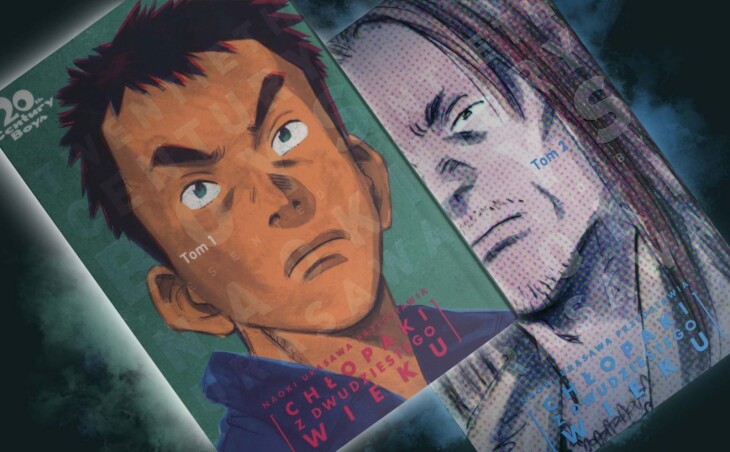Nostalgia. The leitmotif of pop culture in the last few years. Every now and then the titles refer to the magical past: Pennywise haunts the big screens, Nastek guards the little ones, and on the pages of the comic, Papierówki wander time and space. Naoki Urasawa overtook this trend thanks to the Twentieth Century Boys , started in 1999 , who (finally!) Appeared in Poland.
Sunny, idyllic suburbs. A group of heroes whose fates we follow on different time planes. Nostalgic past, problematic present. And evil has been growing stronger over the years. All this is described on thousands of pages. No, this is not a summary of another King novel. The description above is 20th Century Boys. Twentieth Century Boys – a magnum opus by Japanese cartoonist and screenwriter Naoki Urasawa.
Book of prophecies
Using the plot scheme popularized by the American writer, the mangaka (apparently being his big fan) told a multi-threaded, but quite clear story that took place over several decades. In 1967, a gang of outcasts Kenji, Otcho, Yoshitsune, Keroyon, Donkey and the only girl in the company – Yukiji – form a secret club. One of their activities is describing the potential end of the world, which they perpetuate in the so-called Book of Prophecies. Decades later, San Francisco and London fall victim to biological attacks. The mysterious leader of the cult is responsible for all the events – a Friend who, for unknown reasons, implements the plan using seemingly innocent children’s games. The “guys” must reassemble to avert a global tragedy.
While all THIS seems to be pun intended , the more Urasawa unfolds her story, the more unique dimension she gains. At the same time, I warn you in advance that the creator has a tendency to “spinning”. Other titles by this author published in Poland: Monster and Pluto are veritable tapeworms in which the plot develops slowly over the course of many chapters. The same is the case with Chłopaki, whose first two volumes are merely an introduction to a story written on over a thousand pages during the ten years of the original publishing cycle. Therefore, if someone is looking for a quick answer and a clear plot from the beginning, he should choose a different title.
The comic has a lot of plots and characters, and sometimes it deliberately confuses the leads. The narrative focuses on certain individuals who soon become victims of the sect. Additionally, story jumps into the future and the past appear on the pages of the pages. Events are presented in several (ten?) Time lines. I have recently been lucky with this type of work, because I am reviewing Jam jest Legion and its prequel Legion. The chronicles operated with a very similar procedure. At the same time, Urasawa’s manga wins with the Francophone title in the run-up – multithreading understandable to the reader makes sense only when it is written on an appropriate number of pages.
Kenji and the other guys
Unlike the Suckers of Derry from To, the grown-up heroes of the Boysthey did not reach social heights. We are not dealing here with scientists, stars, rich, great of this world, but with everyman, “ordinary” representatives of the low and middle classes. In this way, everyday life becomes one of the key elements of the story. Most of the time is devoted to Kenji, who, before (as predicted) becomes a savior, has to deal with the hardships of running a 24-hour shop and raising his niece, whose mother has disappeared under mysterious circumstances. Having devoted so much space to moral threads, Urasawa deepens the character’s character and makes the reader cheer for them more. Admittedly, there were some lapses – e.g. an obese figure is presented in a very stereotypical way,
Nostalgia trip
Earlier, I indicated a certain saturation of contemporary pop culture with retro motifs that can even be described as “nostalgia porn”. However, this is not a new phenomenon. Just like the movie It emphasizes the coolness of the 1980s, the original book (after all, it was created in 1986) romanticizes King’s childhood, i.e. the 1950s. Regardless of the time of creation, all the most important works of the nostalgic trend refer to the past and cultural themes from the USA, so it is very refreshing to observe a similar approach transplanted into Japanese soil. The comic contains a huge number of references, although at the same time some of them can be understood only by real otaku or thanks to footnotes (I myself recognized without the help of Ultraman only).
The beauty of simplicity
As is often the case in Japan, mangaka is responsible not only for the script, but also for the visuals. And compared to the plot, the drawings are much more conservative. It is useless to look for impressive views, complicated frame compositions and other formal experiments in Chłopaki . At the same time, the artist’s line is neat and perfectly refined. Heroes from the past (where they were full of verve and energy) can be easily associated with their adult counterparts (with characteristic tired eyes). It is worth mentioning that the Hanami publishing house has published the title in the best possible version – kanzenban . This means that the comic has a larger format (A5) and has some color on some pages.
A good friend
Can an adult take responsibility for the inventions of childhood? This seemingly absurd question gives rise to one of the most interesting manga I have ever dealt with. The work is absolutely worth knowing, but definitely not for a fast-paced reader. May the subsequent volumes maintain the level and bring a satisfactory solution.
Nasza ocena: 9/10
The latest title of Naoki Urasawa defends itself both as another representative of retromania, and as a great position in itself. It is worth making friends with him.Characters: 9/10
GRAPHIC DESIGN: 9/10
STORY: 9/10
EDITION: 9/10

